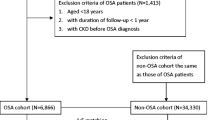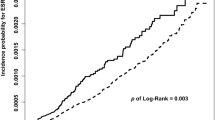Abstract
Purpose
Obstructive sleep apnea (OSA) is a common disorder with a high prevalence among patients with cardiovascular disease (CVD), diabetes, and chronic kidney disease (CKD). Routine evaluation of OSA for patients with CVD including hypertension has been performed according to the clinical guidelines for both OSA and CVD. However, most patients with diabetes and CKD who could benefit from treatment remain undiagnosed because routine screening of OSA is not recognized as part of standard practice. This study aims to evaluate the cost-effectiveness of OSA screening for patients with diabetes and CKD.
Methods
Cost-effectiveness analysis by a decision tree and Markov modeling from the societal perspective in Japan was carried out to provide evidence based on the economic evaluation of current clinical practice concerning diabetes and CKD.
Results
Incremental cost-effectiveness ratios of OSA screening compared with do-nothing were calculated as ¥3,516,976 to 4,514,813/quality-adjusted life year (QALY) (US$35,170 to 45,148/QALY) for diabetes patients and ¥3,666,946 to 4,006,866/QALY (US$36,669 to 40,069/QALY) for CKD patients.
Conclusions
Taking the threshold to judge cost-effectiveness according to a suggested value of social willingness to pay for one QALY gain in Japan as ¥5 million/QALY (US$50,000QALY), OSA screening is cost-effective. Our results suggest that active case screening and treatment of OSA for untreated middle-aged male patients with diabetes or CKD could be justifiable as an efficient use of finite health-care resources in the world with high prevalence of these diseases.



Similar content being viewed by others
References
Peppard PE, Young T, Barnet JH, Palta M, Hagen EW, Hla KM (2013) Increased prevalence of sleep-disordered breathing in adults. Am J Epidemiol 177:1006–1014
Jordan AS, McSharry DG, Malhotra A (2013) Adult obstructive sleep apnoea. Lancet 383:736–747
Bazzano LA, Khan Z, Reynolds K, He J (2007) Effect of nocturnal nasal continuous positive airway pressure on blood pressure in obstructive sleep apnea. Hypertension 50:417–423
Buchner NJ, Sanner BM, Borgel J, Rump LC (2007) Continuous positive airway pressure treatment of mild to moderate obstructive sleep apnea reduces cardiovascular risk. Am J Respir Crit Care Med 176:1274–1278
Young T, Skatrud J, Peppard PE (2004) Risk factors for obstructive sleep apnea in adults. JAMA 291:2013–2016
Epstein LJ, Kristo D, Strollo PJ Jr, Friedman N, Malhotra A, Patil SP et al (2009) Clinical guideline for the evaluation, management and long-term care of obstructive sleep apnea in adults. J Clin Sleep Med 5:263–276
Harada Y, Oga T, Chin K, Takegami M, Takahashi K, Sumi K et al (2012) Differences in relationships among sleep apnoea, glucose level, sleep duration and sleepiness between persons with and without type 2 diabetes. J Sleep Res 21:410–418
Sakaguchi Y, Shoji T, Kawabata H, Niihata K, Suzuki A, Kaneko T et al (2011) High prevalence of obstructive sleep apnea and its association with renal function among nondialysis chronic kidney disease patients in Japan: a cross-sectional study. Clin J Am Soc Nephrol 6:995–1000
Shaw JE, Punjabi NM, Wilding JP, Alberti KG, Zimmet PZ, International Diabetes Federation Taskforce on Epidemiology and Prevention (2008) Sleep-disordered breathing and type 2 diabetes: a report from the International Diabetes Federation Taskforce on Epidemiology and Prevention. Diabetes Res Clin Pract 81:2–12
Turek NF, Ricardo AC, Lash JP (2012) Sleep disturbances as nontraditional risk factors for development and progression of CKD: review of the evidence. Am J Kidney Dis 60:823–833
Marshall NS, Wong KK, Liu PY, Cullen SR, Knuiman MW, Grunstein RR (2008) Sleep apnea as an independent risk factor for all-cause mortality: the Busselton Health Study. Sleep 31:1079–1085
Nakayama-Ashida Y, Takegami M, Chin K, Sumi K, Nakamura T, Takahashi K et al (2008) Sleep-disordered breathing in the usual lifestyle setting as detected with home monitoring in a population of working men in Japan. Sleep 31:419–425
Chin K, Nakamura T, Takahashi K, Sumi K, Matsumoto H, Niimi A et al (2006) Falls in blood pressure in patients with obstructive sleep apnoea after long-term nasal continuous positive airway pressure treatment. J Hypertens 24:2091–2099
Yokoyama H, Okudaira M, Otani T, Takaike H, Miura J, Saeki A et al (1997) Existence of early-onset NIDDM Japanese demonstrating severe diabetic complications. Diabetes Care 20:844–847
Nakayama M, Sato T, Sato H, Yamaguchi Y, Obara K, Kurihara I et al (2010) Different clinical outcomes for cardiovascular events and mortality in chronic kidney disease according to underlying renal disease: the Gonryo study. Clin Exp Nephrol 14:333–339
Kondo M, Yamagata K, Hoshi SL, Saito C, Asahi K, Moriyama T et al (2012) Cost-effectiveness of chronic kidney disease mass screening test in Japan. Clin Exp Nephrol 16:279–291
Yokoyama H, Araki S, Haneda M, Matsushima M, Kawai K, Hirao K et al (2012) Chronic kidney disease categories and renal-cardiovascular outcomes in type 2 diabetes without prevalent cardiovascular disease: a prospective cohort study (JDDM25). Diabetologia 55:1911–1918
Kimura Y, Takishita S, Muratani H, Kinjo K, Shinzato Y, Muratani A et al (1998) Demographic study of first-ever stroke and acute myocardial infarction in Okinawa, Japan. Intern Med 37:736–745
Fukiyama K, Kimura Y, Wakugami K, Muratani H (2000) Incidence and long-term prognosis of initial stroke and acute myocardial infarction in Okinawa, Japan. Hypertens Res 23:127–135
The Global Lower Extremity Amputation Study Group (2000) Epidemiology of lower extremity amputation in centres in Europe, North America and East Asia. Br J Surg 87:328–337
Izumi Y, Satterfield K, Lee S, Harkless LB, Lavery LA (2009) Mortality of first-time amputees in diabetics: a 10-year observation. Diabetes Res Clin Pract 83:126–131
Ministry of Health, Labour and Welfare (2013) Vital statistics of Japan 2011. Health and Welfare Statistics Association, Tokyo (in Japanese)
Drummond MF, Sculpher MJ, Torrance GW, O’Brien BJ, Stoddart GL (2005) Methods for the economic evaluation of health care programmes, 3rd edn. Oxford University Press, Oxford
Gold RM, Siegel JE, Russel LB, Weinstein MC (1996) Cost-effectiveness in health care and medicine. Oxford University Press, New York
Sakamaki H, Ikeda S, Ikegami N, Uchigata Y, Iwamoto Y, Origasa H et al (2006) Measurement of HRQL using EQ-5D in patients with type 2 diabetes mellitus in Japan. Value Health 9:47–53
Tajima R, Kondo M, Kai H, Saito C, Okada M, Takahashi H et al (2010) Measurement of health-related quality of life in patients with chronic kidney disease in Japan with EuroQol (EQ-5D). Clin Exp Nephrol 14:340–348
Hisashige T (2000) Estimation of the quality of the life in patients with diabetes―economic estimation of healthcare service by disease management: report on Research on Health Services 2000. Ministry of Health, Labour and Welfare of Japan, Tokyo, pp 67-77 (in Japanese)
Saito I, Kobayashi M, Matsushita Y, Mori A, Kawasugi A, Saruta T (2008) Cost-utility analysis of antihypertensive combination therapy in Japan by a Monte Carlo simulation model. Hypertens Res 31:1373–1383
Jenkinson C, Stradling J, Petersen S (1997) Comparison of three measures of quality of life outcome in the evaluation of continuous positive airways pressure therapy for sleep apnoea. J Sleep Res 6:199–204
Hisashige T (2001). Estimation of the burden of disease in patients with diabetes: report on Research on Health Services 2001. Ministry of Health, Labour and Welfare of Japan, Tokyo, pp 91-98 (in Japanese)
Japanese association of dialysis physicians (2012) J Jpn Assoc Dial Phys 27:91–108, in Japanese
Tsutani K, Igarashi A, Fujikawa K, Evers T, Kubin M, Lamotte M et al (2007) A health economic evaluation of aspirin in the primary prevention of cardiovascular disease in Japan. Intern Med 46:157–162
Ikeda S, Kobayashi M (2010) Cost-effectiveness analysis metformin or pioglitazone combined with sulfonylurea in type 2 diabetes mellitus in Japan. J Jpn Diabet Soc 53:469–475 (in Japanese)
Shiroiwa T, Sung YK, Fukuda T, Lang HC, Bae SC, Tsuytani K (2010) International survey on willingness-to-pay (WTP) for one additional QALY gained: what is the threshold of cost effectiveness? Health Econ 19:422–437
Brunetti M, Shemilt I, Pregno S, Vale L, Oxman AD, Lord J et al (2013) GRADE guidelines: 10. Considering resource use and rating the quality of economic evidence. J Clin Epidemiol 66:140–150
Fleetham J, Ayas N, Bradley D, Fitzpatrick M, Oliver TK, Morrison D et al (2011) Canadian Thoracic Society 2011 guideline update: diagnosis and treatment of sleep disordered breathing. Can Respir J 18:25–47
Pietzsch JB, Garner A, Cipriano LE, Linehan JH (2011) An integrated health-economic analysis of diagnostic and therapeutic strategies in the treatment of moderate-to-severe obstructive sleep apnea. Sleep 34:695–709
Weatherly HL, Griffin SC, Mc Daid C, Durée KH, Davies RJ, Stradling JR et al (2009) An economic analysis of continuous positive airway pressure for the treatment of obstructive sleep apnea-hypopnea syndrome. Int J Technol Assess Health Care 25:26–34
Sadatsafavi M, Marra CA, Ayas NT, Stradling J, Fleetham J (2009) Cost-effectiveness of oral appliances in the treatment of obstructive sleep apnoea-hypopnoea. Sleep Breath 13:241–252
Mar J, Rueda JR, Duran-Cantolla J, Schechterz C, Chilcott J (2003) The cost-effectiveness of nCPAP treatment in patients with moderate-to-severe obstructive sleep apnoea. Eur Respir J 21:515–522
Conflict of interest
The authors declare that they have no conflict of interest.
Author information
Authors and Affiliations
Corresponding author
Rights and permissions
About this article
Cite this article
Okubo, R., Kondo, M., Hoshi, Sl. et al. Cost-effectiveness of obstructive sleep apnea screening for patients with diabetes or chronic kidney disease. Sleep Breath 19, 1081–1092 (2015). https://doi.org/10.1007/s11325-015-1134-x
Received:
Revised:
Accepted:
Published:
Issue Date:
DOI: https://doi.org/10.1007/s11325-015-1134-x




